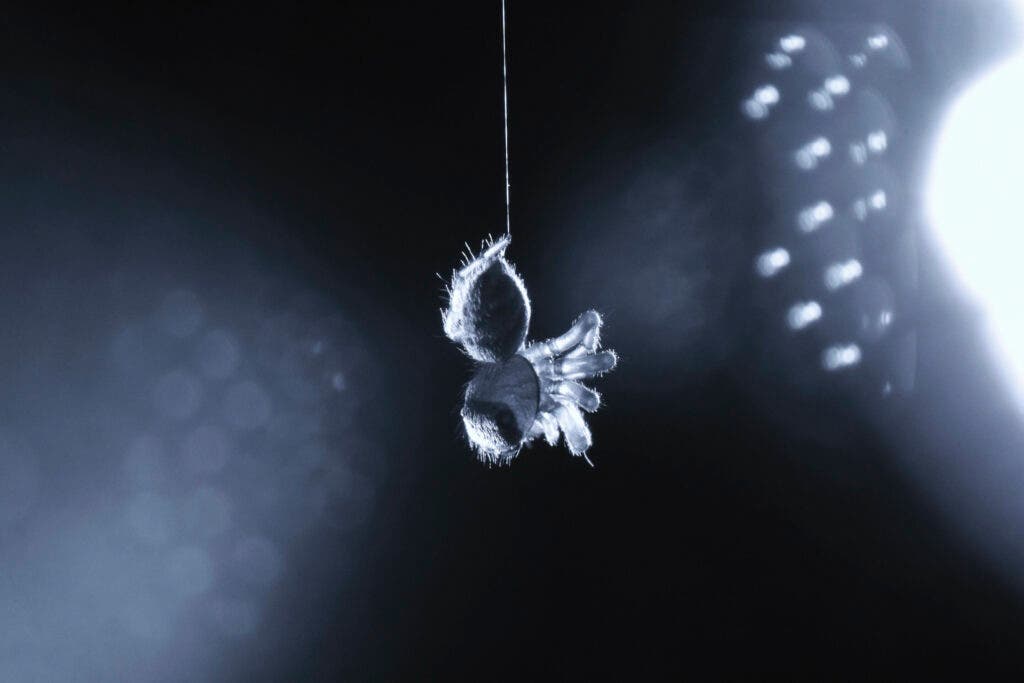A good night’s sleep needs that deep-sleep state known as REM sleep. Spiders seem to agree, according to new research.

A team of researchers led by members at the University of Konstanz in Germany has answered a question you probably never asked: do spiders sleep? According to the findings, these eight-legged critters do indeed enter a “REM sleep-like state” at night.
Although this behavior outwardly resembles human sleeping patterns, we’re not yet sure if what we’re seeing is technically sleeping or not.
Arachnid dreaming
The team explains that the idea for this research arose when Daniela Roessler, an evolutionary biologist at the University of Konstanz in Germany and lead author of the paper, discovered some jumping spiders hanging from their threads in their lab containers at night. These animals had recently been brought to the lab for another research project.
Curious to observe this behavior unfolding, the team installed video cameras to record infant jumping spiders during the night. This footage, they explain, revealed behavioral patterns reminiscent of those displayed by humans during REM sleep: their legs twitched and parts of their eyes flickered.
In humans, REM — which stands for “Rapid Eye Movement” — sleep is an active part of our rest cycle during which surprisingly high levels of brain activity can be observed. It is closely linked with dreaming and, outwardly, is characterized by motions of the eyes, eyelids, arms, and legs.
Other animals are known to engage in REM sleep just like we do. But we didn’t have any clue whether species such as the jumping spider would, on account of them being much less studied. What the researchers were seeing was very similar to the twitching of cats or dogs during REM sleep. Taking into account those similarities, and the ones between our own sleeping patterns and the baby spiders’ “REM sleep-like state”, the researchers decided to look deeper into the issue.
“It was just the most unusual thing I’ve ever seen,” Roessler said of the suspended spiders.
One particular complication in this research was that spiders and several species that are similar to them don’t have movable eyes. This would make it harder to recognize REM sleeping patterns for them, patterns that are strongly determined using the motion of an individual’s eyes.
But the predatory jumping spiders have adapted to allow them to look around while they hunt. The species moves their retinas, instead of their whole eye to change the direction of their gaze. This would allow the team to check if rapid eye movements were indeed happening. Further aiding their research is the fact that baby jumping spiders have see-through outer skeletons, allowing for their inner eyes to be monitored without interfering with the animals.
The team reports that jumping spiders do indeed engage in REM sleep-like behavior during the night, exhibiting elements such as eye movements and twitching of their many legs. It’s not yet clear whether the spiders are actually sleeping, in the technical sense of the word, while they are exhibiting these behaviors. It could be a coincidence, and these behaviors owed to something else entirely, as spiders are very, very far removed from us on the evolutionary tree — they might not even require REM sleep in the same way as we do, and would then not even be capable of entering this sleeping state.
Testing for this would include, for example, checking if the spiders respond more slowly or not at all to various triggers while in this state.
Whichever way the findings point, they would undoubtedly help us better understand why we ourselves enter REM sleep and the ways in which it serves our bodies. It seems to be an integral part of our bodies’ maintenance processes, giving our brains time to tidy up — both physically and mentally. It also seems to play a part in allowing our subconscious to release some of its tension and stress. That being said, REM sleep remains very mysterious, but maybe these baby spiders can help change that.
The paper “Regularly occurring bouts of retinal movements suggest an REM sleep–like state in jumping spiders” has been published in the journal Proceedings of the National Academy of Sciences.









